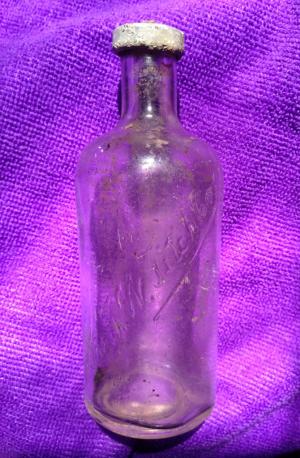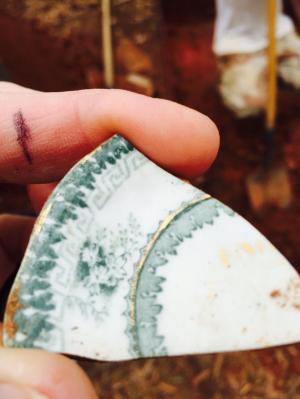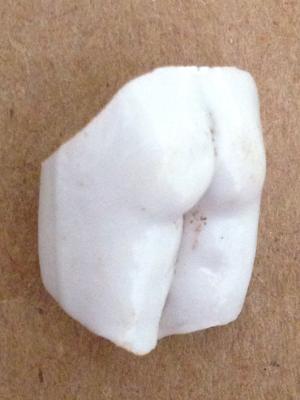St. Joseph's Students Help Excavate Old Cobb House Site

Photo Credit: Terrell Austin
St. Joseph's students (l-r) Allie McClure, Gemma Alvarez, Allison Ramirez, Brandon Ponce and Sierra Curry retrieve an artifact, as archaeologist Tom Gresham looks on.
To a middle-school student, second grade is ancient history, half a lifetime ago. But St. Joseph’s Catholic School seventh and eighth graders recently got the chance to visit their former elementary campus, on the corner of Prince Avenue and Pulaski Street, vacant since 2012.
In some ways the school grounds seemed frozen in time by the things left behind—clay sculptures, mosaic art, a cemetery for class hamsters and bricks painted with children’s names lining paths overgrown with jimson weed.
But the students weren’t there simply to mine forgotten treasure from their early school days. They were assisting with the exploration of the former site of an antebellum mansion that once stood on more than 20 acres stretching from the “road to Jefferson,” later named Prince Avenue, all the way to the north end of Pulaski Street. The project was an archeological dig on the grounds of the old T.R.R. Cobb House.

Photo Credit: Terrell Austin
In May 1873, at age 51, Marion McHenry Lumpkin Cobb sold the large Greek revival house where she had lived since 1844, when her parents gave it to her as a wedding present upon her marriage to Thomas Reade Rootes Cobb. In this house, she bore six children, buried three and sent her husband off to a war he was instrumental in fomenting and from which he would never return.
She also sold a corner parcel with a small structure on it to the Diocese of Savannah for the establishment of Athens’ first Catholic Church. Over the years, the house changed hands many times and was used as a fraternity house, a dentist’s office, a boarding house and, from 1909–1915, the private residence of the Dobbs family, whose name can still be seen inscribed adjacent to the sidewalk on Prince Avenue.
In 1962, 90 years after the church founders purchased land from Mrs. Cobb, the church bought her house for use as a rectory and later as a convent. By 1984, the need for a new school building and the prohibitive cost of the upkeep prompted the church to offer the house, listed on the National Register of Historic Places, for free to anyone who could move it. After local efforts foundered, Stone Mountain Memorial Association stepped in and transported the house to become part of its commemorative tourist attraction, because of T.R.R. Cobb’s instrumental role in the Civil War as ardent secessionist, brigadier general and primary author of the Confederate Constitution.
Once the house was reassembled at Stone Mountain, though, the association was unable to muster the funds to restore it, and it sat, surrounded by a chain link fence and with tarps, for 19 years. In 2004, the deterioration of the historic property was brought to the attention of the Watson-Brown Foundation by the Georgia Trust for Historic Preservation, and the foundation began working with local historic preservationists to find a suitable new site for the house in Athens. The house was moved to 175 Hill St., 200 yards from its original site, and meticulously restored to its 1860 appearance. It opened in 2007 as the T.R.R. Cobb House Museum, offering a variety of free educational programs to local schools.

Photo Credit: Terrell Austin
The April 2015 dig was a partnership between the T.R.R. Cobb House Museum and St. Joseph’s school, led by the local firm Southeastern Archeological Services (SAS). With the property in flux and vacant, the museum education staff and St. Joseph’s teachers saw a brief opportunity to explore the site where the Cobb house stood from the time it was built, around 1830, until 1985.
As the museum began working with local historian Gary Doster to compile a year-by-year history of the house and its inhabitants, the archeologists determined the approximate location of the house and developed an excavation plan. The students who would be participating were briefed on the scientific methods employed in the field and were prepared for a unique opportunity to apply them in a historical context.
SAS warned staff and students that, as with any dig, the effort might yield little more than pieces of broken bricks and glass. The removal of the house, the grading of the site and the construction of the school might have eradicated most traces of the past. Still, the opportunity was there to investigate and potentially answer questions regarding the original structure and features of the house that weren’t previously documented. In addition, surprisingly little archaeological work has been done at historic sites in Athens. In the case of the T.R.R. Cobb House, there was ample known history of the house to provide context for any finds. At the very least, the operation would be fun and educational and students would have the chance to participate in a real dig.

Photo Credit: Terrell Austin
After some exploratory shovel tests around the property, the SAS team hit the jackpot, locating an underground root cellar, projected to be 18 feet by 18 feet with the floor 5 feet below the surface. Even more exciting was the discovery, a few days later, of an old well shaft about 13 feet in diameter. Once these two features were identified, almost every shovelful yielded something of interest: an intact F.W. Fitch and Co. hair tonic bottle from the 1930s, shards of china with colorful patterns dating from the 1840s to 1915, an atlatl (dart) weight and a tiny but unmistakable bare bottom of a broken china doll.
The students screened dirt, washed and organized artifacts and kept field notes. As objects came clean in the plastic tubs of muddy water under the trees at their old school, it wasn’t hard to imagine a fraternity boy getting ready for a date, a Cobb or Dobbs table laid for dinner, a prehistoric hunter carving a precise groove into a piece of soapstone or a young girl carefully changing the clothes of a delicate doll.
The T.R.R. Cobb House and St. Joseph’s plan to exhibit the artifacts, photographs from the dig and newly discovered historic documents pertaining to the house in September 2015.









comments